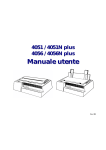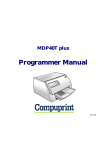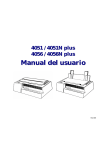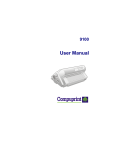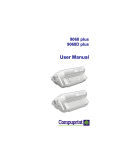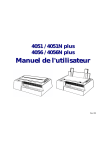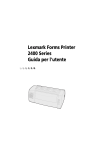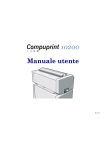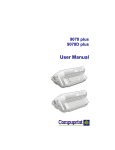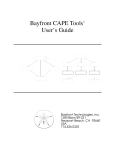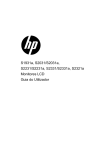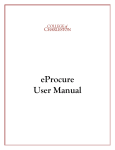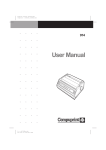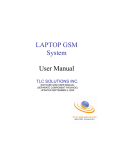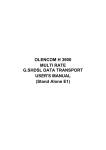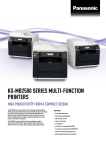Download User Manual
Transcript
4051 plus 4056 plus User Manual Compuprint Information Thanks for choosing this printer. Your printer is a reliable working equipment that will be very useful in your daily job. Our printer has been designed to be compact and respectful of the work environment. It offers a wide range of features and multiple functions that confirm the high technological level reached by the Compuprint S.p.A . To maintain unchanged in the long run these printing performances, Compuprint has developed specific consumable accessories for each printer type (for example: ribbon cartridges for dot matrix printers, toner and OPC cartridges for laser printers, bubble ink jet cartridges for inkjet printers) that assure an excellent operation with high printing quality level reliability. Compuprint recommends to use only its original consumables with original packaging (identified by its holographic label). In this way, a proper use of the printer at quality level unreliability stated in the product characteristics can be assured. All typical usage problems related to not certificated consumables may be avoided, such as an overall quality print level degradation and ,often, the reduction of the product life due to the fact that the proper print heads working conditions, OPC cartridge and other printer parts are not assured. Moreover, Compuprint does not only certify its consumables in terms of working conditions but also carefully controls their compliance with the international standard rules concerning: • no cancerous materials; • no inflammability of the plastic materials; • other standards Compuprint advices the customers not to use products for which the compliance to this safety rules are not warranted. Finally seek your dealer or contact a Compuprint office and be sure that are provided you the original Compuprint consumables. A78408744-002 i FCC Notes FCC Notes This equipment has been tested and found to comply with the limits for a Class B digital device, pursuant to Part 15 of the FCC Rules. These limits are designed to provide reasonable protection against harmful interference when the equipment is operated in a commercial environment. This equipment generates, uses and can radiate radio frequency energy and, if not installed and used in accordance with the instruction manual, may cause harmful interference to radio communications. However, there is no guarantee that interference will not occurin a particular installation. If this equipment does cause harmful interference to radio or television reception, which can be determined by turning the equipment off and on, the user is encouraged to try to correct the interference by one or more of the following measures: • • • Reorient or relocate the receiving antenna. Increase the separation between the equipment and the receiver to outlets on different circuits. Consult the dealer or an experienced radio/TV technician for help. Changes or modifications not expressly approved by the party responsible for compliance could avoid the user's authority to operate the equipment. The use of a non-shielded interface cable with the referenced device is prohibited. The length of the parallel interface cable must be 3 meters (10 feet) or less. The length of the serial interface cable must be 15 meters (50 feet) or less.. Canadian D.O.C. Radio Interference Regulation This digital apparatus does not exceed the Class B limits for radio noise emission from digital apparatus as set out in the radio interference regulations of the Canadian Department of Communications. Le présent appareil numérique n'émet pas de bruits radioélectriques dépassant les limites applicables aux appareils numériques de classe A prescrites dans le règlement sur le brouillage radioélelctrique édicté par le ministère des communications du Canada. EEC Regulations This equipment conforms to the EEC Directive 89/392 (the sound pressure, measured according to ISO 7779, does not exceed 70 dBA). ii A78408744-002 Safety Information Safety Information A. Never remove any printer cover unless it is necessary for the installation of a printer accessory and expressly described in this manual. B. Please retain the printer covers in a safe place because they should be reinstalled if you decide to remove any printer accessory. The following areas of the printer should be covered for safety reasons: The above openings must always be protected with their cover when the corresponding option is not installed. Do not touch inside and do not insert any object into these openings or into the gears. A78408744-002 iii Table of Contents Table of Contents Compuprint Information................................................................................ i FCC Notes .........................................................................................................ii Canadian D.O.C. Radio Interference Regulation.......................................... ii EEC Regulations ............................................................................................ ii Safety Information........................................................................................ iii Table of Contents ........................................................................................... iv Getting to Know Your Printer ..................................................................... 1 Printer Features ............................................................................................. 1 4051 plus Model Specific Features ............................................................ 1 4056 plus Model Specific Features ............................................................ 1 Common Features ...................................................................................... 1 Unpacking Your Printer................................................................................. 2 Printer Parts................................................................................................... 2 Front View .................................................................................................. 2 Rear View.................................................................................................... 3 Setting Up Your Printer ................................................................................ 3 Choosing a Suitable Location ........................................................................ 3 Printer Assembly............................................................................................ 4 Ribbon Cartridge Installation.................................................................... 4 Paper Chute Installation ........................................................................... 7 Host Computer Connection............................................................................ 9 Parallel Connection .................................................................................... 9 Serial Connection ..................................................................................... 10 Software Driver Selection ............................................................................ 10 Power Connection......................................................................................... 10 Selecting the Display Language ................................................................ 12 Configuring the Printer .............................................................................. 13 Operator Panel Presentation ....................................................................... 13 Display Messages ..................................................................................... 13 Indicators .................................................................................................. 16 Function Keys........................................................................................... 16 Buzzer ....................................................................................................... 21 Printer Setups ............................................................................................... 22 Entering the Printer Setups .................................................................... 22 Moving within the Printer Setups ........................................................... 22 Leaving the Printer Setups...................................................................... 22 iv A78408744-002 Table of Contents Power on Configuration Setup..................................................................... 23 Entering the Power-On Configuration .................................................... 23 Program Setup.............................................................................................. 32 Entering the Program Setup.................................................................... 32 Paper Handling ............................................................................................. 38 Paper Specifications ..................................................................................... 38 Fanfold Paper ........................................................................................... 38 Cut Sheets................................................................................................. 38 Cut Sheets..................................................................................................... 39 Loading Cut Sheets .................................................................................. 39 Fanfold Paper .............................................................................................. 41 Inserting Fanfold Paper ........................................................................... 41 Parking Fanfold Paper ............................................................................. 45 Switching From Fanfold Paper to Cut Sheet .......................................... 46 Top of Form Adjustment .............................................................................. 47 Tear Off Line Adjustment ............................................................................ 48 Printer Maintenance and Troubleshooting ............................................ 49 Cleaning the Printer .................................................................................... 49 Replacing the Ribbon Cartridge .................................................................. 49 Printing the Self Test ................................................................................... 50 Error Handling ............................................................................................. 51 Options ............................................................................................................ 53 Automatic Sheet Feeder............................................................................... 53 Unpacking Automatic Sheet Feeder........................................................ 53 Preparing the Printer............................................................................... 54 Installing the Automatic Sheet Feeder ................................................... 56 Paper Specifications ................................................................................. 58 Paper Loading........................................................................................... 59 How to Keep the Automatic Sheet Feeder Clean ................................... 61 Removing the Automatic Sheet Feeder................................................... 62 Problem Solving........................................................................................ 63 Printer Specifications.................................................................................. 64 A78408744-002 v Table of Contents vi A78408744-002 Getting to Know Your Printer Printer Features 4051 plus Model Specific Features • • • • 9 Needle Print Head Draft printing at 480 cps and in Letter Quality at 120 cps IBM Proprinter XL III, EPSON FX Series emulations High resolution printing at 240 x 144 dots per inch 4056 plus Model Specific Features • • • • 24 Needle Print Head Draft printing at 480 cps and in Letter Quality at 133 cps IBM Proprinter XL24, XL24 AGM, EPSON LQ 1050/2550 emulations High resolution printing at 360 x 360 dots per inch Common Features • • • • • • • 136 columns Operator panel with a Liquid Crystal Display (16 alpha-numeric characters), three leds and eight function keys to control the operating printer state Easy usage through the Operator Panel and through software commands An Automatic Sheet Feeder (option) that handles large quantities of single sheets and allows simultaneous use of fanfold paper Printing of the commonly used bar codes Plug & Play capability for Windows 95/98 Bidirectional IEEE 1284 parallel interface and standard serial RS232/C and RS-422/A interface A78408744-002 1 Getting to Know Your Printer Unpacking Your Printer Together with the user manual, the following items are included in the box: Notify any damage to your supplier. Printer Parts Front View 2 A78408744-002 Setting Up Your Printer Rear View Setting Up Your Printer Choosing a Suitable Location Consider the following points when you choose the location for your printer: • • • • The distance between the printer and the host computer must not exceed the length of the interface cable; The location must be sturdy, horizontal and stable; Your printer must not be exposed to direct sunlight, extreme heat, cold, humidity or dust see “Printer Specifications” later; You need an AC Power Outlet compatible with the plug of the printer’s power cord. The voltage of the outlet must match the voltage shown on the printer’s Rating Plate. After selecting an installation location, install the printer making sure that there is sufficient space for operation. A78408744-002 3 Setting Up Your Printer Printer Assembly Ribbon Cartridge Installation It is advisable to insert the ribbon cartridge while the printer is turned off. However, your printer can be turned on during this procedure, but do not forget that it must be disabled to print (Wait displayed and READY led turned off). 1. Remove the printer cover by pressing simultaneously the two buttons in the front part of the cover. 2. If you are inserting the ribbon cartridge for the first time, do not forget to complete the unpacking procedure by taking off the plastic hooks that fix the paper bail. 4 A78408744-002 Setting Up Your Printer 3. Pull the paper thickness lever towards the front of the printer to facilitate ribbon insertion 4. Remove the new ribbon cartridge from its bag. Remove and discard the holdfast (1) that blocks the ribbon. Turn the tension knob (2) to tighten the ribbon. 5. Insert the ribbon (1) between the print head (2) and the print head mask (3). Lay the cartridge over the printer carriage (4). Make sure that the two pins on each side of the cartridge are positioned over the retaining clips of the printer carriage. A78408744-002 5 Setting Up Your Printer 6. Push the cartridge gently down while turning the tension knob (1). Make sure that the cartridge clips into place (2). 7. To tighten the ribbon, turn the tension knob in the direction shown by the arrow on the ribbon cartridge. 8. Replace the printer cover by first inserting the hooks (1) into the appropriate grooves (2) and then release the cover ensuring that clips in place. 6 A78408744-002 Setting Up Your Printer 9. Move the paper thickness lever according to the paper type: • If a cut sheet is loaded move the lever towards the back of the printer. • If a multicopy chemical paper is loaded, first move the lever completely towards the back of the printer, then 1 notch towards the front of the printer for each copy. • If a carbon multicopy paper is loaded, first move the lever completely towards the back of the printer, then 2 notches towards the front of the printer for each copy. Now, you can load the paper and print your first test document (see later in this section). If the pattern does not satisfy your expectation, adjust the paper thickness lever. When printing on multipart paper follow the above instructions to avoid damaging the print head. Paper Chute Installation To insert the paper chute correctly, make sure that you are in front of the printer and that you hold the paper chute in the front position A78408744-002 7 Setting Up Your Printer 1. Insert the hook on the left side of the paper chute in the groove situated near the paper entry slot. The figure shows the back of the printer and the paper chute in the back position for a good view of the hook and groove. For this reason, you will see the left side of the paper chute shown on the right 2. Flex the paper chute towards the front of the printer and insert the hook on the opposite side of the paper chute in the corresponding groove. This printer accessory may assume two different positions according to the paper type: down position for fanfold paper (A) and raised position for single sheet (B) 8 A78408744-002 Setting Up Your Printer 3. If you wish to position the paper chute down, lift it towards the back of the printer and push it gently down until it stops. If you wish to place the paper chute in the raised position, lift it and hook it firmly. Host Computer Connection This printer can be connected to your host computer via two available interfaces. The interface connectors are located on the rear of the printer. • A bidirectional IEEE1284 parallel interface • A RS-232C/422A serial interface Make sure that both printer and host computer are switched off Parallel Connection Insert the parallel interface cable into the parallel connector and fasten it by means of the clips. A78408744-002 9 Setting Up Your Printer Serial Connection Insert the serial interface cable into the serial connector, and fasten it by means of the two screws (use the screwdriver). Software Driver Selection At this point it is necessary to configure your printer for your application package. The installation procedures depend upon the host environment: Follow the instructions in the readme file you find on the CD-ROM. In a WINDOWS 95 environment the printer supports the Plug & Play feature. The printer drivers of all Compuprint printers can be found at the Internet Address http://www.compuprint.net. Power Connection Make sure that the power outlet matches the power rating of the printer. See the name plate of the printer, that you find in the rear of the printer. Make sure that the power outlet is near the printer location and easily accessible 10 A78408744-002 Setting Up Your Printer 1. Make sure that the power switch at the rear of the printer is on "printer off" position. Insert one end of the power cable plug into the printer connector placed on the rear of the printer. 2. Insert the other end of the power cable in a convenient outlet. 3. To turn the printer on, press the part of the power switch that now is up. The print head moves and stops at about 6.5 inches from the left side of the printer and the indicators on the operator panel light up for a few seconds. Every time the printer is turned off and on again, wait 3 seconds before turning it on. A78408744-002 11 Selecting the Display Language Selecting the Display Language The display messages for this printer can be displayed in two different languages: English (Default) and Italian. To select the language that you prefer, proceed as follows: 1. Enter the Power on Configuration procedure. • • Make sure that the printer is turned off. Keep the PROGRAM key pressed while you turn on the printer. After the initialization phase the following message will be displayed: INSTALLATION 2. Press the → key to select the function. 3. Press the ↓ key until the language first level function is displayed: LANGUAGE 4. Press the → key to select the function. The following message will be displayed: * English The symbol ‘ * ’ means that the shown parameter is the selected one, in this case it is the default value. 5. Press the → key to select it. Press the PROGRAM key to exit the Power on Configuration procedure. From now the display message will appear in the selected language. 12 A78408744-002 Configuring the Printer Configuring the Printer Operator Panel Presentation The operator panel consists of three elements: • Display: you can see on the display various messages usually regarding the printing functions. • Indicators: give information about the operating state of the printer. • Function keys: allow you to change operating state of the printer as necessary. Display Messages The display messages can be divided into three main groups: SETUP MESSAGES give information about the current operating printer state. are displayed during the printer setup procedure. See "Printer Setups" later in this section. ERROR MESSAGES signal the printer faults. STATUS MESSAGES Basic Indications on the Display When turning the printer on, after the message 405x, the display indicates the printer status (Ready, Wait, Busy, Quiet.), the current macro (M1, M2, M3, M4) and the selected emulation (IBM XL III or EPSON FX for the 4051 plus printer and IBM XL 24E, IBM XL24 AGM and EPSON for the 4056 plus printer) as follows: Ready A78408744-002 M1-EPS 13 Configuring the Printer The following list shows you the status and error messages in alphabetical order: 1. Position lever Displayed when manual paper loading is not successful. Verify the position of the selection lever. 1. Tear-off paper Displayed when Park operation is not successful. 2. Park paper 2. Remove paper Displayed when Park operation is not successful. Displayed when the paper ejection is not successful 4051 plus or 4056 plus This message appears on the display immediately after turning the printer on to indicate that it is initializing to its power on setting. The print head moves to its initial position. The printer is logically disconnected from the host and is disabled to receive data. The READY indicator is turned off. Bin 1 Displayed when is selected ASF 1 feed. Bin 1/2 Displayed when is selected ASF 1/2 feed. Bin 2 Displayed when is selected ASF 2 feed. Buffer cleared Displayed after input buffer clearing (all the stored data are erased). Call Service Displayed in rolling mode together with the failure message to indicate a call to Service. Carriage error Displayed when there is an unrecoverable carriage error. This means that the printer carriage does not move correctly. When the Carriage error message is displayed, the indicator READY blinks. Check that the ribbon cartridge is not used up neither damaged. Check connection Displayed when a DSR, DCD, or CTS signal fault occurs. Check interface Displayed when an Input buffer overflow occurs Check its moving Displayed when a carriage fault occurs. Check line Displayed when a communication error occurs. Comm. failure Displayed when a communication error occurs Data lost Displayed when an Input buffer Overflow occurs. Fanfold This is one of the messages that will be displayed when you press PATH (Shift function). Press the SHIFT key to select the fanfold paper loading. 14 A78408744-002 Configuring the Printer Fanfold thru ASF This is one of the messages that will be displayed when you press PATH (Shift function). Press the SHIFT key to select the handling of the fanfold paper with the Automatic Sheet Feeder (option) installed. Initializing Displayed while the printer is turned on. Invalid keypress An invalid pressing of a key has occurred. Labels This is one of the messages that will be displayed when you press PATH (Shift function). Press the SHIFT key to select the fanfold paper with adhesive label loading. Load Displayed when a paper out occurs. Loading paper Displayed when there is a paper loading request (fanfold or cut sheet). Manual This is one of the messages that will be displayed when you press PATH (Shift function). Press the SHIFT key to select the cut sheet loading. NVM changed Displayed when NVM contents has been changed. Parking paper Generic status message for all parking operations. Press any button Generic user intervention message. Press Park You are requested to press the PARK key. Printer failure Displayed in case of fault during the initialization. Printing test Displayed while the self-test is running. Processing Generic wait message for an operation. Quiet --- OFF Displayed when the Quiet function is not selected. Quiet --- ON Displayed when the Quiet function is selected. Ready M1-EPS Displayed when the printer is on line and ready to print. Release button Generic user intervention message. Remove paper Displayed when Eject operation is not successful. Self-test Displayed during the self test procedure. You can select the test procedure keeping pressed the ON LINE key while turning on the printer. The printer is disabled to receive data from the host and the READY indicator is unlit. To stop test procedure press again the ON LINE key. A78408744-002 15 Configuring the Printer Serial I/F error Displayed when a DSR, DCD, or CTS signal fault occurs. Shift Displayed every time that the SHIFT key is pressed to indicate that the Shift function is selected. Stand-by Displayed when the printer is in stand-by status. Top cover open Displayed as long as the top cover is open. Wait M1-EPS Displayed when the printer is unable to print. The indicator READY is unlit. Indicators READY Lit Blinking Unlit PROGRAM Lit Unlit SHIFT Lit Unlit When the printer is enabled to receive and print data. The printer is unable to receive and print data ( Wait message displayed) but there is still data in the input buffer. When the printer is unable to print because: • the test procedure is running • the printer initialization is running When the PROGRAM function of the operator panel keys has been selected and enabled. When the normal function of the operator panel keys is selected. When the SHIFT function of the operator panel keys has been selected and enabled. When the normal function of the operator panel keys is selected. Function Keys Each key can select one of the three available function modes: Normal, Program or Shift. • The Normal function does not require previous action to be selected. • The Program function is selected by pressing the PROGRAM key when the printing is disabled. Keep pressed this key while turning on the printer until the message Release button is displayed, the Power on Configuration Setup will be entered. Pressing this key while the printer is in Wait (indicator READY unlit) the Program Setup will be entered. • The Shift function is selected by pressing the SHIFT key. This function key is disabled when the Program function is selected. 16 A78408744-002 Configuring the Printer ON LINE Key ON LINE Normal Function • • • Pressing this key you will obtain different results depending on the printer status: When the READY indicator is lit on, pressing this key you will cause the stop of the printing at the end of the current line; the READY indicator blinks if there is some data left in the Input buffer, otherwise the indicator is turned off and the Wait message will be displayed. When the READY is unlit or is blinking pressing this key the printing will be enabled and the READY indicator is turned on. • Program Function Pressing this key while powering the printer on, the message Printing test is displayed and the check test is executed. If you want to stop the self-test press this key again. Pressing this key you will obtain different results depending on the interface configuration (parallel or serial interface). • In parallel configuration, the information in the Input buffer is reset and the Buffer cleared message will be displayed. • In serial configuration, the information in the Input buffer is reset. LOAD/PATH Key LOAD PATH Normal Function Shift Function If you press this key while the printer is unable to print you will obtain the following effects: • No action if paper is already present. The Invalid keypress will be displayed • If paper is not present, pressing this key, the paper is loaded according to the drive selection lever selection • If the ASF is installed, the paper is loaded from the selected ASF bin. This key selects the paper type and it is enabled when the printing is disabled. The display shows the paper type you can use. If you want to select the displayed paper type, release the key and do not press it again within 1 sec. The paper types are: Fanfold - Labels - Fanfold Thru Asf Bin 1 - Bin 2 A78408744-002 - Manual - 17 Configuring the Printer FF/PARK Key FORM FEED PARK ← Normal Function Shift Function Program Function Pressing this key while the printer is offline causes: • The paper, if loaded, advances at new page or, if parked, is positioned on the first printable line. • The cut sheet, if loaded, is ejected (max. 21 inches) or a new cut sheet will be loaded. No action if the paper is not present. Invalid keypress message is displayed. Fanfold paper, present in the printer, is set in parking position. Parking paper is displayed. Cut sheet, already inserted, is ejected. The ← function allows you to get at the previous level of the Printer Setup. LF/QUIET Key LINE FEED QUIET → Normal Function Shift Function Program Function It is available when printing is disabled. This function causes a paper advancement to the next printable line. Keeping pressed this key for more than a second, you will obtain the continuous execution of paper advancing. It allows a noise level reduction. Keeping pressed this key Quiet---OFF and Quiet--- ON will be displayed in rolling mode. If you want to enable this function, release this key when the message Quiet---ON is displayed. On the display remains the message Quiet. To disable this function release this key when Quiet --- OFF is displayed. If QUIET mode is selected while the printer is printing , it will be activated at the end of the current line. The function → allows you to get to the next level of the Printer Setup. When SELECT MACRO is displayed, pressing → key the selected and operating macro will be displayed. Using the ↑ and the ↓ keys you will be able to display all the selectable macros. (MACRO n is displayed). Pressing the → key the displayed macro is selected and using the ↑ and ↓ keys the selectable parameters will be displayed. Select the parameter to be modified by pressing the → key (the selected and active value is marked with an asterisk (*) on the left of the value itself), press the ↑ and the ↓ keys to select it then press → key to confirm it. 18 A78408744-002 Configuring the Printer FONT Key ↑ Normal Function FONT Shift Function ↑ Program Function The ↑ (MICRO FEED FORWARD) function is available when the printer is not printing and causes a forward micro feed of the paper. Keeping pressed this key for a second, the paper will advance in continuous mode at the speed of 3.5 ips (slew speed). The FONT function will be enabled. This function allows you to choose among the selectable fonts. Keeping pressed this key or pressing it within 1 second, the fonts will be scrolled. Release this key when the name of the requested font is displayed or do not pressed again within a second. The font messages are: Draft - Courier - Gothic OCR-A - OCR-B for the 4051 plus printer and Draft - Courier – Roman – Boldface – Prestige – Script -Presentor - OCR-A OCR-B for the 4056 plus printer. The ↑ (Up arrow) key allows you to scroll upwards the functions that are present in a function level, or to scroll upwards the function values if you are at selection level. The numeric values are incremented. PITCH Key ↓ Normal Function PITCH Shift Function ↓ Program Function The ↓ function is available when the printing is not printing and allows to move backwards the paper with a micro advancement. Keeping pressed this key for a second, the paper moves backwards in continuous mode at the speed of 3.5 ips (slew speed). The PITCH function allows you to select the available horizontal spacing. Keeping pressed this key or pressing it within a second the spacings will be scrolled. Release the key when the desired spacing is displayed or do not press it again within a second. Available horizontal spacings (CPI): 5 - 6 - 7.5 - 8.55 - 10 - 12 - 15 - 17.1 - 20 A78408744-002 The ↓ function allows to scroll downwards the functions that are in a level, or to scroll downwards the function values if you are at a selection level. The numeric values are decremented. 19 Configuring the Printer PROGRAM Key PROGRAM Normal Function Keeping pressed this key while you turn on the printer you will enter Power on Configuration Setup. Pressing this key when the printer is unable to print, (indicator READY unlit) you will enter the Program Setup and the Program Function of keys are enabled. The PROGRAM indicator is turned on when the function is enabled. Pressing this key when the PROGRAM indicator is turned on, the Program Function is disabled and the indicator turned off. Program Function If you press this key while you are in the Program Setup you will exit the configuration mode saving the function values that have been changed. If changes occurred, the message SAVE MACRO? will be displayed. Now, if you press the PROGRAM key you will exit the function and the new values will be only used as current ones. (When you turn off the printer you will loose any change you have made).If you press the → key, you will exit the Program Function and the modified values of the selected macro will be stored in a permanent mode. SHIFT Key SHIFT 20 Normal Function Press the SHIFT key to select the Shift Function of the keys. The SHIFT indicator lits on and the message Shift will be displayed as long as a key available for this function is pressed. Pressing this key when the SHIFT indicator lit up the Shift Function. will be disabled and the indicator lit off. A78408744-002 Configuring the Printer Buzzer This printer is provided with a buzzer to indicate particular conditions according to the problem detected.: • • • • 1 short "beep" (0,25 sec): the BEL code has been sent; when the buzzer sound stops, the printer returns to normal operation. Continuous "beep": the printer cover has been raised when the printer is enabled to print. Close the cover and make sure that the message Wait (READY indicator unlit) is displayed before raising the cover again. 4 long "beeps": a fault condition has occurred. See later "Error Handling". 4 short "beeps": A condition of paper end or paper removal has occurred. A78408744-002 21 Printer Setups Printer Setups You can customize the printer depending on your needs via the Power on Configuration Setup and the Program Setup procedures. Entering the Printer Setups The PROGRAM key allows to enter the Printer Setups. • Keep pressed the PROGRAM key while powering the printer on to enter the Power on Configuration Setup • Press the PROGRAM key when the printer is disabled (READY indicator unlit) to enter the Program Setup When you enter the desired Printer Setup, the Program functions, described above the key area, will be enabled. Moving within the Printer Setups The arrow keys ↑, ↓, ←, → are used to move within the different functions inside the Printer Setups. • Use the ↓ key to scroll forward the functions (next ones) and ↑ to scroll them backwards (previous ones). • Use the → key to select the next function or the value and ← to display the previous one. • When the desired value is displayed, press the → key to select it. Leaving the Printer Setups Whenever you wish to leave the current Printer Setup, proceed as follows: • In the Power-On Configuration, press the PROGRAM key and the new settings will be automatically stored. The printer leaves the Power on Configuration Setup and is disabled to print (READY indicator unlit). • In the Program Setup, press the PROGRAM key and if any change occurred the message SAVE MACRO? will be displayed. Press the PROGRAM key and the modified values will be used as current settings (When the printer will be turned off they will be lost) or the key → to store the changes in a permanent way. 22 A78408744-002 Printer Setups Power on Configuration Setup The default values are marked with an asterisk (*) on the left. These are the available functions: INSTALLATION INTERFACE PRINT STATUS RECALL FACTORY This function contents general parameters such as Protocol, Emulation and the display language. This function defines the interface physical type and communication features. This function allows to print the current printer configuration. This function allows to reset the factory default values. Entering the Power-On Configuration 1. Make sure that the printer is turned off. 2. Keep pressed the PROGRAM button key while turning on the printer. The 4051 plus or 4056 plus message will be displayed then Release button message. 3. Release the button key and the following message will be displayed: INSTALLATION INSTALLATION Function Emulation Selection RECALL FACTORY BUZZER ↑ INSTALLATION ↑ → or ← PROTOCOL ↓ ↓ INTERFACE IBM/EPSON MODE IBM XL III IBM XL 24E IBM XL 24E AGM EPSON FX EPSON LQ A78408744-002 → or ← IBM xx EPSON xx ↑ or ↓ ↑ or ↓ IBM XL III emulation (4051 plus only - default). IBM XL 24E emulation (4056 plus only - default). IBM XL 24E AGM emulation (4056 plus only). EPSON FX Series emulation (4051 plus only). EPSON LQ 1050/2550 emulation. 23 Printer Setups IBM Mode PROTOCOL ↑ → or ← IBM MODE ↓ EPSON MODE IBM C-SET (1/2) NATION 20 CPI IBM C-SET (1/2) NATION 20 CPI ↑ or ↓ ↑ or ↓ ↑ or ↓ → or ← → or ← → or ← IBM set... CP 437 ... 20 CPI no IBM character sets selection. IBM national character sets selection. IBM compressed printing selection. - IBM Character Sets 20 CPI ↑ → or ← IBM C-SET (1/2) ↓ IBM set 1 (*) IBM set 2 ↑ or ↓ ↑ or ↓ NATION IBM set 1 IBM set 2 IBM CS1 character set selection. IBM CS2 character set selection. - IBM National Character Sets IBM C-SET (1/2) ↑ → or ← NATION ↓ 20 CPI CP 437 (*) ... ISO 8859/9 ↑ or ↓ ↑ or ↓ ↑ or ↓ Selection of the following IBM National Character Sets: CP 437(*) CP 855 CP 864 GOST ISO 8859/5 CP437 G CP 857 CP 865 TASS ISO 8859/6 CP850 CP 858 CP 866 ISO 8859/1 ISO 8859/7 CP851 CP 860 CP 867 ISO 8859/2 ISO 8859/8 CP 852 CP 862 CP 876 ISO 8859/3 ISO 8859/9 CP 853 CP 863 CP 877 ISO 8859/4 ISO 8859/15 - IBM Compressed Printing NATION ↑ 20 CPI → or ← ↓ 20 CPI no (*) 20 CPI yes ↑ or ↓ ↑ or ↓ IBM C-SET (1/2) 20 CPI no 20 CPI yes The compressed printing is performed at 17.1 cpi. The compressed printing is performed at 20 cpi. EPSON Mode PROTOCOL ↑ EPSON MODE ↓ → or ← NATION EPSON C-SET ↑ or ↓ ↑ or ↓ → or ← → or ← USA Italics .... LINE MODE NATION EPSON C-SET 24 EPSON national character sets selection EPSON character sets selection. A78408744-002 Printer Setups - EPSON National Character Sets EPSON C-SET ↑ → or ← NATION ↓ EPSON C-SET ↑ or ↓ ↑ or ↓ ↑ or ↓ USA (*) ... ISO 8859/15 Selection of the following EPSON National character sets: USA (*) ITALY LATIN A1 CP 853 CP 863 CP 877 ISO 8859/4 ISO 8859/15 FRANCE SPAIN 1 CP 437(*) CP 855 CP 864 GOST ISO 8859/5 GERMANY JAPAN CP437 G CP 857 CP 865 TASS ISO 8859/6 ENGLAND NORWAY CP850 CP 858 CP 866 ISO 8859/1 ISO 8859/7 DENMARK1 DENMARK 2 CP851 CP 860 CP 867 ISO 8859/2 ISO 8859/8 SWEDEN SPAIN 2 CP 852 CP 862 CP 876 ISO 8859/3 ISO 8859/9 - EPSON Character Sets NATION ↑ EPSON C-SET → or ← ↓ NATION Italic Graphic 1 Graphic 2 Italic Graphic 1 Graphic 2 (*) ↑ or ↓ ↑ or ↓ ↑ or ↓ EPSON Italic character set selection. EPSON Graphic 1 character set selection. EPSON Graphic 2 character set selection. Line Mode EPSON MODE ↑ LINE MODE ↓ TEAR/VIEW MODE LF=LF,CR=CR CR=LF+CR LF=LF+CR LF&CR=LF+CR A78408744-002 → or ← LF=LF, CR=CR (*) CR=LF+CR LF=LF+CR LF&CR=LF+CR ↑ or ↓ ↑ or ↓ ↑ or ↓ ↑ or ↓ If the printer receives a LF code (LF), it only performs a line feed. If the printer receives a CR code (CR), performs a carriage return. If the printer receives a CR code (CR), it performs a carriage return followed by a line feed. If the printer receives a LF code (LF), it performs a line feed. If the printer receives a LF code (LF), it performs a line feed followed by a carriage return. If the printer receives a CR code (CR), it only performs a carriage return. If the printer receives a LF code (LF) or a CR code (CR), it performs both a line feed and a carriage return. 25 Printer Setups Tear/View Mode LINE MODE ↑ TEAR/VIEW MODE → or ← ↓ LANGUAGE Auto.advance 1s ... 5s Manual advance No tear Auto.advance. 1s (*) ... Auto.advance. 5s Manual advance No tear ↑ or ↓ ↑ or ↓ ↑ or ↓ ↑ or ↓ ↑ or ↓ Paper moves automatically to the tear/view position after the specified time-out (1s. to 5s.) Paper moves to the tear/view position using the ON LINE key. Tear/view mode is disabled. It is useful to print labels or paper that backward movements may cause a paper jam. Display Language Selection TEAR/VIEW MODE ↑ LANGUAGE → or ← ↓ English (*) Italiano ↑ or ↓ ↑ or ↓ BUZZER This function selects the language of the display messages: in English or Italian language. Enable/Disable Buzzer LANGUAGE ↑ BUZZER → or ← ↓ Enabled (*) Disabled ↑ or ↓ ↑ or ↓ PROTOCOL This function enables or disables the buzzer. INTERFACE Function Interface Type INSTALLATION HIGH GUARD LEVEL ↑ INTERFACE ↓ PRINT STATUS Automatic Parallel Serial 26 ↑ → or ← INTERFACE TYPE ↓ I/F TIME-OUT → or ← Automatic (*) Parallel Serial ↑ or ↓ ↑ or ↓ ↑ or ↓ The interface type is automatically selected according to the data transmission. Parallel interface selection. Serial interface selection. A78408744-002 Printer Setups Interface Time-out INTERFACE TYPE ↑ → or ← TIME-OUT I/F ↓ INPUT BUFFER 2 seconds (*) ... 30 seconds ↑ or ↓ ↑ or ↓ ↑ or ↓ This function defines the time duration (2 to 30 sec.) after which the interface switches to the other. Input Buffer Size I/F TIME-OUT ↑ → or ← INPUT BUFFER ↓ PARALLEL MODE 256 (DLL) ... 32K (No DLL) (*) ↑ or ↓ ↑ or ↓ ↑ or ↓ This function selects the input buffer size with one of the following values: 256, 4K, 8K, 16K or 32 K. The 16K and the 32K values do not allow the DLL. The most suitable value for the DLL function is 256(DLL). Parallel I/F Mode INPUT BUFFER ↑ → or ← PARALLEL MODE ↓ Parallel CX Bidirectional (*) ↑ or ↓ ↑ or ↓ AUTOFEED SIGNAL Parallel CX Bidirectional Parallel interface in Centronics monodirectional mode. Parallel interface in IEEE 1284 bidirectional standard mode. AUTOFEED Signal PARALLEL MODE ↑ AUTOFEED SIGNAL → or ← ↓ Enabled Disabled (*) ↑ or ↓ ↑ or ↓ SLCT-IN SIGNAL Enabled Disabled The parallel interface uses the AUTOFEED signal. The parallel interface ignores the AUTOFEED signal. SELECT-IN Signal AUTOFEED SIGNAL ↑ SLCT-IN SIGNAL ↓ → or ← Disabled (*) Enabled ↑ or ↓ ↑ or ↓ SERIAL TYPE Enabled Disabled A78408744-002 The parallel interface uses the SELECT-IN signal. The parallel interface ignores the SELECT-IN signal. 27 Printer Setups Serial Interface Type SLCT-IN SIGNAL ↑ SERIAL TYPE → or ← ↓ RS232C (*) RS422A ↑ or ↓ ↑ or ↓ SERIAL MODE This function selects the serial interface type: RS-232/C or RS-422/A. Serial Connection Mode SERIAL TYPE ↑ SERIAL MODE → or ← ↓ Local (*) Remote ↑ or ↓ ↑ or ↓ WORD LENGTH This function selects the serial connection type: local or remote. Data Format SERIAL MODE ↑ WORD LENGTH → or ← ↓ 7 bit 8 bit (*) ↑ or ↓ ↑ or ↓ BAUD RATE This function selects the data format, using 7 or 8 bits. Baud Rate WORD LENGTH ↑ BAUD RATE → or ← ↓ PARITY BIT 600 bps ... 9600 bps (*) ... 38400 bps ↑ or ↓ ↑ or ↓ ↑ or ↓ ↑ or ↓ ↑ or ↓ This function selects the data transmission speed in bits per second (bps). The values available are: 600, 1200, 2400, 4800, 9600, 19200, 38400. Parity Check BAUD RATE ↑ PARITY BIT ↓ BUFFER CONTROL Even Odd Mark Space None 28 → or ← Even Odd Mark Space None (*) ↑ or ↓ ↑ or ↓ ↑ or ↓ ↑ or ↓ ↑ or ↓ Parity check is enabled for even parity. Parity check is enabled for odd parity. Parity check disabled and the transmitted parity bit is always in Mark state. Parity check disabled and the transmitted parity bit is always in Space state. Parity check (for 8 data bits only). A78408744-002 Printer Setups Buffer Control PARITY BIT ↑ BUFFER CONTROL → or ← ↓ DTR XON/XOFF (*) ↑ or ↓ ↑ or ↓ ROBUST XON This function selects the buffer control protocol: DTR or XON/XOFF. Robust XON BUFFER CONTROL ↑ ROBUST XON → or ← ↓ No (*) Yes ↑ or ↓ ↑ or ↓ HIGH GUARD LEVEL This function selects the execution of Robust XON. High Guard Level ROBUST XON ↑ HIGH GUARD LEVEL ↓ INTERFACE TYPE → or ← 10% Buffer Size ... 90% Buffer Size (*) ↑ or ↓ ↑ or ↓ ↑ or ↓ Selects the percentage of the input buffer to fix to the High Guard Level signal. A78408744-002 29 Printer Setups PRINT STATUS Function • Press the → key to select the function. The message Printing test will displayed while the following output will be printed: 405x plus: CONTROLLER:78XXXXXX Rel.:x.xx GENERATOR: 78XXXXXX OPTIONS FONT DRAFT MODE. VERTICAL PITCH LPI LOCK PAGE LENGTH TOP MARGIN BOTTOM MARGIN HORIZONTAL PITCH CPI LOCK LEFT MARGIN RIGHT MARGIN SLASHED ZERO MULTICOPY PRINT DIRECTION CURRENT VALUES MACRO1* MACRO2 MACRO3 MACRO4 Draft Normal Draft Normal Draft Normal Draft Normal Draft Normal 6 lpp Disabled 66 lines Line #1 Line #66 6 lpp Disabled 66 lines Line #1 Line #66 6 lpp Disabled 66 lines Line #1 Line #66 6 lpp Disabled 66 lines Line #1 Line #66 6 lpp Disabled 66 lines Line #1 Line #66 10 cpp Disabled Column #1 Column #136 10 cpp Disabled Column #1 Column #136 10 cpp Disabled Column #1 Column #136 10 cpp Disabled Column #1 Column #136 10 cpp Disabled Column #1 Column #136 No No Soft. control No No Soft. control No No Soft. control No No Soft. control No No Soft. control INTERFACE INTERFACE TYPE I/F TIME-OUT PRINT ADJUSTMENT Automatic 2 seconds INPUT BUFFER 32 k (No DLL) PARALLEL MODE AUTOFEED SIGNAL SLCT-IN SIGNAL Bidirectional Disabled Disabled SERIAL TYPE SERIAL MODE BAUD RATE WORD LENGTH PARITY BIT BUFFER CONTROL ROBUST XON HIGH GUARDLEVEL 30 Rel.:x.xx RS232C Local 9600 bps 8 bit None XON/XOFF INSTALLATION BIDI. ALIGNEMENT. TOP OF FORM Offset: 0 0/90 inches PROTOCOL IBM MODE IBM XL xx TEAR PERFO ALIGN 0/90 inches SET-C IBM (1/2) IBM set 1 NATION 20 CPI EPSON MODE CP437 20 CPI no NATION EPSON C-SET USA Graphic2 LINE MODE TEAR/VIEW MODE LANGUAGE BUZZER LF=LF,CR=CR Auto.advance1s English Enabled No 90% Buffer Size A78408744-002 Printer Setups RECALL FACTORY Function • Press the → key to select this function. The values of the functions return to the factory default setting. All values of the functions are reset to the factory default ones in both Power on Configuration Setup and Program Setup. These are the default values: OPTIONS FONT DRAFT MODE. VERTICAL PITCH LPI LOCK PAGE LENGTH TOP MARGIN BOTTOM MARGIN HORIZONTAL PITCH CPI LOCK LEFT MARGIN RIGHT MARGIN SLASHED ZERO MULTICOPY PRINT DIRECTION CURRENT VALUES MACRO1* MACRO2 MACRO3 MACRO4 Draft Normal Draft Normal Draft Normal Draft Normal Draft Normale 6 lpp Disabled 66 lines Line #1 Line #66 6 lpp Disabled 66 lines Line #1 Line #66 6 lpp Disabled 66 lines Line #1 Line #66 6 lpp Disabled 66 lines Line #1 Line #66 6 lpp Disabled 66 lines Line #1 Line #66 10 cpp Disabled Column #1 Column #136 10 cpp Disabled Column #1 Column #136 10 cpp Disabled Column #1 Column #136 10 cpp Disabled Column #1 Column #136 10 cpp Disabled Column #1 Column #136 No No Soft. control No No Soft. control No No Soft. control No No Soft. control No No Soft. control INTERFACE INTERFACE TYPE I/F TIME-OUT PRINT ADJUSTMENT Automatic 2 seconds INPUT BUFFER 32 k (No DLL) PARALLEL MODE AUTOFEED SIGNAL SLCT-IN SIGNAL Bidirectional Disabled Disabled SERIAL TYPE SERIAL MODE BAUD RATE WORD LENGTH PARITY BIT BUFFER CONTROL ROBUST XON HIGH GUARD LEVEL A78408744-002 RS232C Local 9600 bps 8 bit None XON/XOFF INSTALLATION BIDI. ALIGNEMENT. TOP OF FORM Offset: 0 0/90 inches PROTOCOL IBM MODE IBM XL xx TEAR PERFO ALIGN 0/90 inches SET-C IBM (1/2) IBM set 1 NATION 20 CPI EPSON MODE CP437 20 CPI no NATION EPSON C-SET USA Graphic2 LINE MODE TEAR/VIEW MODE LANGUAGE BUZZER LF=LF,CR=CR Auto.advance1s English Enabled No 90% Buffer Size 31 Printer Setups Program Setup The default values are These are the available functions: SELECT MACRO PRINT ADJUSTMENT PRINT STATUS HEX DUMP marked with an asterisk (*). This function defines four different macros and allows to configure the printer for different job types. This function allows the adjustment of the mechanical parameters and the tuning of the first printing line. This function allows to print the current printer configuration. This function allows to enable the Hexadecimal Dump mode. Entering the Program Setup To enter the Program Setup procedure, proceed as follows: 1. Make sure that the printer is not enabled to print (READY indicator unlit). 2. Press the PROGRAM key. The following message will be displayed: SELECT MACRO SELECT MACRO Function MACRO SELECTION HEX. DUMP. MACRO 4 ↑ SELECT MACRO ↓ PRINT ADJUSTMENT ↑ → or ← MACRO 1 ↓ MACRO 2 → or ← FONT DRAFT MODE VERTICAL PITCH LPI LOCK PAGE LENGTH TOP MARGIN BOTTOM MARGIN HORIZONTAL PITCH CPI LOCK LEFT MARGIN RIGHT MARGIN SLASHED ZERO MULTICOPY PRINT DIRECTION ↑ or ↓ ↑ or ↓ ↑ or ↓ ↑ or ↓ ↑ or ↓ ↑ or ↓ ↑ or ↓ ↑ or ↓ ↑ or ↓ ↑ or ↓ ↑ or ↓ ↑ or ↓ ↑ or ↓ ↑ or ↓ This function allows to select one of the four available print environments. 32 A78408744-002 Printer Setups Font Selection PRINT DIRECTION ↑ FONT → or ← ↓ DRAFT MODE Draft (*) ... OCR-A ↑ or ↓ ↑ or ↓ ↑ or ↓ Selects the type of character to use : Draft, Courier, Gothic, OCR-A, OCR- B. for the 4051 plus model and Draft Courier, Roman, Prestige, Presentor OCRA, Script, Boldface. OCR-A and OCR-B may be selected only when the nonproportional pitch is selected. Boldface may be selected only when the proportional pitch is selected. Draft Mode FONT ↑ DRAFT MODE → or ← ↓ Normal (*) High speed ↑ or ↓ ↑ or ↓ VERTICAL PITCH This function selects the draft printing speed: Normal or High Speed. Vertical Spacing DRAFT MODE ↑ VERTICAL PITCH → or ← ↓ LPI LOCK 6 lpi (*) ... 12 lpi 3 lp/30 mm ... 12 lp/30 mm ↑ or ↓ ↑ or ↓ ↑ or ↓ ↑ or ↓ ↑ or ↓ ↑ or ↓ This function determines the density with which the lines are printed according to different units: lines printed per inch (6, 8, 12 lpi) or lines per 30 mm (3, 4, 6, 8, 12 lp/30 mm). Lpi Lock VERTICAL PITCH ↑ LPI LOCK → or ← ↓ Enabled Disabled (*) ↑ or ↓ ↑ or ↓ PAGE LENGTH Enabled Vertical spacing can be changed only by the operator panel keys. Disabled Vertical spacing can be changed by software or by operator panel keys. Page Length LPI LOCK ↑ PAGE LENGTH ↓ TOP MARGIN → or ← NUMBER OF LINES A4 (11.6 inches) A5 (8 inches) ↑ or ↓ ↑ or ↓ ↑ or ↓ → or ← 1 line (*) ... 126 lines ↑ or ↓ ↑ or ↓ ↑ or ↓ This function selects the physical page length in n° of lines (1 to 126 lines at 1/6”) or in standard formats (A4 or A5). A78408744-002 33 Printer Setups Top Margin PAGE LENGTH ↑ TOP MARGIN → or ← ↓ BOTTOM MARGIN Line #1 (*) ... Line #X ↑ or ↓ ↑ or ↓ ↑ or ↓ This function selects the top margin defined as n° of lines (at 1/6”). The value X corresponds to the n° of lines set in the PAGE LENGTH function. Bottom Margin TOP MARGIN ↑ BOTTOM MARGIN → or ← ↓ HORIZONTAL PITCH Line #1 ... Line #66 (*) ... Line #126 ↑ or ↓ ↑ or ↓ ↑ or ↓ ↑ or ↓ ↑ or ↓ This function selects the bottom margin defined as n° of lines (at 1/6”). The value X corresponds to the n° of lines set in the PAGE LENGTH function. Horizontal Spacing BOTTOM MARGIN ↑ HORIZONTAL PITCH → or ← ↓ CPI LOCK 5 cpi ... 10 cpi (*) ... 20 cpi ... Proportional ↑ or ↓ ↑ or ↓ ↑ or ↓ ↑ or ↓ ↑ or ↓ ↑ or ↓ ↑ or ↓ This function sets the horizontal spacing at the following values: 5, 6, 8.55, 10, 12, 15, 17.1, 20 cpi or the proportional spacing. Cpi Lock HORIZONTAL PITCH ↑ → or ← CPI LOCK ↓ Enabled Disabled (*) ↑ or ↓ ↑ or ↓ LEFT MARGIN Enabled Disabled Horizontal spacing is selected only by operator panel (PITCH key). The horizontal spacing is selected by the operator panel (PITCH key) or by software. Left Margin CPI LOCK ↑ LEFT MARGIN ↓ RIGHT MARGIN → or ← Column 1 (*) ... Column 136 ↑ or ↓ ↑ or ↓ ↑ or ↓ This function sets the left margin defined as n° of columns. The physical margin position depends on the selected horizontal spacing. 34 A78408744-002 Printer Setups Right Margin LEFT MARGIN ↑ RIGHT MARGIN → or ← ↓ SLASHED ZERO Column 1 ... Column 136 (*) ↑ or ↓ ↑ or ↓ ↑ or ↓ This function sets the right margin defined as number of columns. The physical margin position depends on the selected horizontal spacing. Zero Character Typeface RIGHT MARGIN ↑ SLASHED ZERO → or ← ↓ Yes No (*) ↑ or ↓ ↑ or ↓ MULTICOPY This function selects the zero character printing with (Yes) or without slash (No). Multicopy Form SLASHED ZERO ↑ MULTICOPY → or ← ↓ Yes No (*) ↑ or ↓ ↑ or ↓ FONT This function selects the printing on multicopy format paper (Yes) or on normal paper (No). Print Direction MULTICOPY ↑ PRINT DIRECTION ↓ FONT → or ← Unidirectional Bidirectional Soft. control (*) ↑ or ↓ ↑ or ↓ ↑ or ↓ This function selects the print direction: unidirectional, bidirectional o controlled by software. A78408744-002 35 Printer Setups PRINT ADJUSTMENT Function Bidirectional Print Alignment SELECT MACRO. TEAR PERFO ALIGN ↑ ↑ PRINT ADJUSTMENT → or ← BIDI. ALIGNMENT: ↓ ↓ PRINT STATUS TOP OF FORM → or ← Offset: +6 ... Offset: -6 ↑ or ↓ ↑ or ↓ ↑ or ↓ This function adjusts the bidirectional printing in a range between - 6 and +6. When the previous value is changed, the printer prints two ‘|’ lines to control the final output. Top of Form (ToF) BIDI. ALIGNEMENT ↑ TOP OF FORM → or ← ↓ TEAR PERFO ALIGN 0/90 inches ... 990/90 inches ↑ or ↓ ↑ or ↓ ↑ or ↓ This function adjusts the top of the form in n/90 inch. The values range between 0 and 990. At value selection level, the printer prints a **x/90**string, where the x value indicates the current value corresponding to the current ToF position. If the value is changed, the new value will be printed from its corresponding ToF position. See “Top of Form Adjustment” in the “Paper Handling” section. Tear Position Alignment TOP OF FORM ↑ TEAR PERFO ALIGN ↓ BIDI. ALIGNEMENT → or ← 0/90 inches ... 990/90 inches ↑ or ↓ ↑ or ↓ ↑ or ↓ This function adjusts the tear off position in n/90 inch. The values range between 0 and 990. At value selection level, the tear off line position aligns to the corresponding tear off border of the printer cover. Pressing the ↑ or ↓ keys, the tear off position moves in steps of 1/90 inch. When the tear off perforation line is set in the desired position, selects this value. 36 See “Tear Off Line Adjustment” in the “Paper Handling” position. A78408744-002 Printer Setups PRINT STATUS Function Press the → key to select the function. The message Printing test will displayed while the following output will be printed: 405x plus: CONTROLLER:78XXXXXX Rel.:x.xx GENERATOR: 78XXXXXX OPTIONS CURRENT VALUES MACRO1* MACRO2 MACRO3 MACRO4 Draft Normal Draft Normal Draft Normal Draft Normal Draft Normal 6 lpp Disabled 66 lines Line #1 Line #66 6 lpp Disabled 66 lines Line #1 Line #66 6 lpp Disabled 66 lines Line #1 Line #66 6 lpp Disabled 66 lines Line #1 Line #66 6 lpp Disabled 66 lines Line #1 Line #66 10 cpp Disabled Column #1 Column #136 10 cpp Disabled Column #1 Column #136 10 cpp Disabled Column #1 Column #136 10 cpp Disabled Column #1 Column #136 10 cpp Disabled Column #1 Column #136 No No Soft. control No No Soft. Control No No Soft. control No No Soft. control No No Soft. control Automatic 2 seconds BIDI. ALIGNEMENT. TOP OF FORM Offset: 0 0/90 inches PROTOCOL IBM MODE TEAR PERFO ALIGN 0/90 inches SET-C IBM FONT DRAFT MODE. VERTICAL PITCH LPI LOCK PAGE LENGTH TOP MARGIN BOTTOM MARGIN HORIZONTAL PITCH CPI LOCK LEFT MARGIN RIGHT MARGIN SLASHED ZERO MULTICOPY PRINT DIRECTION INTERFACE INTERFACE TYPE I/F TIME-OUT PRINT ADJUSTMENT INPUT BUFFER 32 k (No DLL) PARALLEL MODE AUTOFEED SIGNAL SLCT-IN SIGNAL Bidirectional Disabled Disabled SERIAL TYPE SERIAL MODE INSTALLATION RS232C Local BAUD RATE WORD LENGTH PARITY BIT BUFFER CONTROL ROBUST XON HIGH GUARD LEVEL Rel.:x.xx 9600 bps 8 bit None XON/XOFF IBM XL x (1/2) IBM set 1 NATION 20 CPI EPSON MODE CP437 20 CPI no NATION EPSON C-SET USA Graphic2 LINE MODE TEAR/VIEW MODE LANGUAGE BUZZER LF=LF,CR=CR Auto.advance1s English Enabled No 90% Buffer Size HEX DUMP Function This function may be selected at any point of the printing. To activate the hexadecimal printing follow this sequence: 1. After entering the Program Setup, the following message will be displayed: HEX DUMP 2. Press the → key to activate this function. Press the ↓ key, the following messages will be alternatively displayed. Hex dump OFF Hex dump ON 4. Release the ↓ key when the hex dump ON message is displayed, to confirm this selection, press → key. The printer will print the data in hexadecimal code as well the ASCII notation: 30 31 32 33 34 35 36 37 38 39 41 42 43 44 45 46 47 48 49 4A 4B 4C 4D 4E 4F 50 51 52 53 54 55 56 57 58 59 5A 0D 0A 0123456789ABCDEF GHIJKLMNOPQRSTUV WXYZ 5. To cancel the hexadecimal printing, set the printer in Wait (READY indicator unlit), press again the PROGRAM key and proceed as described above but now select the Hex dump OFF message. A78408744-002 37 Paper Handling Paper Handling Paper Specifications Use the correct paper in your printer for obtaining good results in your printout. See the information table below: Fanfold Paper Width: Length: Weight: Number of copies: Weight: First sheet Others Carbon: Total thickness: Minimum Maximum (*) Minimum Minimum Maximum 1 original plus 5 copies 76 mm (3 inches) 406 mm (16.55 inches) 76 mm (3 inches) 2 55 g/m 2 80 g/m Minimum Maximum Minimum Maximum Minimum Maximum Maximum 55 g/m 2 75 g/m 2 55 g/m 2 75 g/m 2 14 g/m 2 35 g/m 0,52 mm (0,02 inches) 2 (*) If you are using fanfold paper through the Automatic Sheet Feeder, the maximum width is 381 mm (15 inches). Cut Sheets Width: Length: Weight: Number of copies: Weight: First and last sheets Other sheets Carbon paper Multipart forms 38 Minimum Maximum Minimum Minimum Maximum 101,6 mm (4 inches) 431,8 mm (17 inches) 63,5 mm (2,5 inches) 2 50 g/m 2 120 g/m 1 original plus 5 carbon copies Minimum Maximum Minimum Maximum Minimum Maximum Maximum 55 g/m 2 75 g/m 2 45 g/m 2 75 g/m 2 14 g/m 2 35 g/m 0,52 mm (0,02 inches) 2 A78408744-002 Paper Handling Cut Sheets Cut sheets are inserted from the top of the printer. You can load cut sheet whether fanfold paper is inserted or not. If no fanfold paper is present, proceed as follows; otherwise, go to "Switching From Fanfold Paper to Single Sheet" section. Loading Cut Sheets 1. Put the paper chute in the raised position by pulling and hooking it firmly. Close or extend the paper support bar according to the paper size. 2. If you wish to position the first printing column at 25 mm from the edge of the paper, slide the left paper guide to the left as far as it will go, then adjust the right paper guide according to the paper width. A78408744-002 39 Paper Handling 3. Move the paper thickness lever according to the paper type: • • • If a cut sheet is loaded move the lever towards the back of the printer. If a multicopy chemical paper is loaded, first move the lever completely towards the back of the printer, then 1 notch towards the front of the printer for each copy. If a carbon multicopy paper is loaded, first move the lever completely towards the back of the printer, then 2 notches towards the front of the printer for each copy. Now, you can load the paper and print your first test document (see later in this section). If the pattern does not satisfy your expectation, adjust the paper thickness lever. When printing on multicopy paper, follow the above procedure to avoid damaging the print head. 4. If the printer is turned off, turn the printer on. The display shows Load Paper, if there is no paper in the printer. If you turn the printer on when paper is already inserted, the display will show Remove Paper while buzzer sounds 4 short "beeps". The paper is ejected with a backward movement of maximum 24 inches. If you have not removed the paper yet, the buzzer will sound again 4 short “beeps”. Finally the display will show Load paper. 40 A78408744-002 Paper Handling 5. Feed the cut sheet in the slot. Press the LOAD or FF key. The paper will be loaded to the first printable line. The paper is positioned at the first printable line at 1/6 inch from the top edge of the paper. The last printable line of the sheet is positioned at 0.83 inch (21 mm) from the bottom edge of the paper. Fanfold Paper The fanfold paper must be inserted at the rear of the printer. Inserting Fanfold Paper 1. Put the paper chute in the raised position by lifting and hooking it firmly. A78408744-002 41 Paper Handling 2. Open the tractor cover until it clips into place. 3. Unlock the sprocket on the side of the interface connector and, if it is not already positioned, slide it to the right until it stops. 4. If you wish the first column in a particular position, the ruler under the tractor should be helpful to position the sprocket. The distance between the marks on the ruler is 1/10 inch. 5. Lock the sprocket in place 42 A78408744-002 Paper Handling 6. Unlock the other sprocket and position it in accordance with the paper width. Slide the spacers evenly along the tractor bar 7. Open the sprocket covers. 8. Position the holes in the paper over one sprocket and then over the other. A78408744-002 43 Paper Handling 9. Close the sprocket covers 10. Adjust the two sliders on the tractor cover in alignment with the spacers and close the cover firmly. 11. Put the paper chute in the down position by lifting it towards the back of the printer and pushing gently down until it stops. Space the paper guides evenly on the paper chute. 44 A78408744-002 Paper Handling 12. Place the drive selection lever in the fanfold position (fanfold drawing) and make sure that Fanfold is selected by pressing PATH key (SHIFT function) on the operator panel. 13. If the printer is turned off, turn the printer on (see "Power Connection” section before). The display shows Load paper. 14. Press the LOAD or FF key and the paper will be positioned in front of the print head. The paper is positioned at the first printable line at 1/6 inch from the top edge of the paper. If you want to adjust the paper position, follow the instructions of the "Top of Form Adjustment" section later. The last printable line of the last form is positioned at 0.31 inch (8 mm) from the bottom edge of the paper It is advisable not to print two lines before and two lines after the paper perforation. Parking Fanfold Paper Whenever you wish to park the fanfold paper, follow the sequence: 1. Make sure that the printer is disabled to print (Wait message is displayed and the READY indicator is unlit) and tear the fanfold paper that is currently loaded along the last perforation. 2. Press the SHIFT key and then the PARK key to enable the PARK paper will be displayed, the fanfold function. The message Parking paper will move backwards up to its parking position. The fanfold paper is still inserted into the tractors and ready to be fed as necessary. A78408744-002 45 Paper Handling • When the fanfold paper to park is too long, two messages will be alternatively displayed: 1. Tear-off paper and 2. Remove paper. Tear the printed paper and press again the PARK key. • When you need to load again the fanfold paper, make sure that the drive selection lever is in fanfold position and that the paper type (PATH function) selection is Fanfold. Switching From Fanfold Paper to Cut Sheet If you have been using fanfold paper and you have not removed it, your printer allows the cut sheet sheet loading after performing a parking of the inserted fanfold paper.(PARK function). 1. Make sure that your printer is turned on and disabled to print (READY indicator unlit). Tear the fanfold paper that is currently loaded along the last perforation. 2. You can perform the paper switching as follows: • • Press the SHIFT key and then the PATH key. Select Manual and exit by pressing the SHIFT key. The fanfold paper moves backwards; or Park the fanfold paper (PARK function). The Manual paper feeding is automatically selected when the cut sheet is loaded. 3. Place the drive selection lever in the cut sheet position. The message Load paper will be displayed. Now, your printer is ready to load cut sheet. Follow step1 to 5 in ” Loading Cut Sheets” section. 46 A78408744-002 Paper Handling Top of Form Adjustment The Top of Form Adjustment procedure allows you to adjust the position of the first printable line and therefore it is advisable to perform it immediately after a paper loading. Turn the printer on , if it is not, and proceed as follows: Make sure that the printer is not printing. (READY indicator unlit). If the fanfold paper has been loaded, park it by pressing the PARK key. If the cut sheet has been inserted, eject it by pressing the FF key. 1. Press the PROGRAM key. The following message will be displayed: SELECT MACRO 2. Press the ↓ key until the following message is displayed: PRINT ADJUSTMENT 3. Press the → to select the function. The following message will be displayed: Bidi. Alignment 4. Now go on pressing the ↓ key until the following message will be displayed. Top of form 5. Press the → key to select the function. The paper is unloaded and reloaded at the TOF quote. The current value will be printed and the display will show the following message: 0/90 inches The paper is moved to the view position. While scrolling all the possible values by pressing the ↑ and ↓ keys the paper will be moved. 6. Pressing again the → key the displayed value is selected and printed, after the paper has been taken to the correct position. Then the paper will be taken to the view position. A78408744-002 47 Paper Handling Tear Off Line Adjustment The Tear Off Line Adjustment procedure allows you to adjust the position of the fanfold perforation in order to tear it against the printer tear off border on the cover. This procedure is available only if the Program Setup is previously entered. The Tear Off Line Adjustment procedure can be executed at any time during the printing. Proceed as follows. 1. Make sure that the printer is not enabled to print (READY indicator unlit and the message Wait displayed). 2. Enter the Program Setup by pressing the PROGRAM key. 3. The following message will be displayed: SELECT MACRO 4. Press the ↓ key until the following message will be displayed: PRINT ADJUSTMENT 5. Press the → key to select the function. The following message will be displayed: Bidi.Alignment 6. Now go on pressing the ↓ key until the following message will be displayed: Tear perfo Align 7. The following temporary message will be displayed : Parking paper 8. Now if you press the → key the paper will be unloaded, reloaded and a form feed executed. The paper will be taken to the corresponding tear off line. 9. Pressing the ↑ and ↓ keys you can scroll all the selectable values while the paper will be moved. 10. Pressing again the → key the displayed value will be selected 48 A78408744-002 Printer Maintenance and Troubleshooting Printer Maintenance and Troubleshooting Cleaning the Printer Periodical cleaning will help to keep your printer in top condition. • Use a neutral detergent or a water solution on a soft cloth to clean dirt and grease from the cabinet of the printer. • Do not use an abrasive cloth, alcohol, paint thinner, or other similar agents, because they can cause discolorations and scratchings. • Be careful not to damage the electronic and mechanical components. Replacing the Ribbon Cartridge If the printing is fading, the ribbon could be worn or damaged. It is advisable to remove the used ribbon cartridge while the printer is turned off. However, your printer can be turned on during this procedure, but do not forget that it must be disabled to print (Wait message displayed). Make sure that the new ribbon cartridge is an original Compuprint spare part. If it is not so the quality and reliability level declared in the product features won’t be assured. 1. Remove the printer cover. A78408744-002 49 Printer Maintenance and Troubleshooting 2. Move the printer carriage to the center of the printer. 3. Lift the cartridge off until the clip release it. Now, you are ready to insert a new ribbon cartridge. Follow from step 2 of "Ribbon Cartridge Installation" section. Printing the Self Test It is advisable to print the self-test printout to inform you about the current printer configuration and to check if the printer is working well. Then, proceed as follows: 1. Keep the ON LINE key pressed while you turn the printer on , the display will show the following message Printing test The message Printing test will remain displayed while the following output will be printed 2. Press ON LINE key to stop printing. 50 A78408744-002 Printer Maintenance and Troubleshooting Error Handling The following table will help you to identify and solve problems which may occur when using the printer. If the problem is not listed, or if it is not corrected by any of the methods suggested, contact your supplier for help. Error Message Description Problem Cause Solution Printer fails to Wait is displayed Press ON LINE key to enable printing. print Interface cables are not Push cables firmly into sockets at both properly connected ends Fanfold paper is Paper holes are torn Remove torn paper and replace with not advancing next good sheet. Check the tension of the paper between left and right sprocket wheels. If too tight, loosen, by moving right sprocket wheels slightly to left (see “Paper Handling” before). Reload paper, ensuring that Paper is not correctly corresponding holes at each side of aligned on sprocket paper are correctly aligned on sprocket wheels wheels. The drive selection lever Position lever in the fanfold position is selected in cut sheet position. Print fading Ribbon not feeding Check that ribbon is correctly loaded (see “Ribbon Cartridge Installation” before. Turn the tension knob to ensure that the ribbon is not jammed. Ribbon worn or Replace ribbon. damaged Print head too far from Pull paper thickness lever towards the paper back of the printer to move print head closer to paper. Dark, smudgy Print head too close to Pull paper thickness lever towards the print paper front of the printer to move print head away from paper. Self-test not ON key not Repeat the sequence (see “Printing” LINE printed pressed while turning the Self Test “ before). the printer on. Carriage fault Press ON LINE key and repeat the sequence (see “Printing The Self Test” before). A78408744-002 51 Printer Maintenance and Troubleshooting Problem Cause Solution The display Error in the paper Try to eject the paper using ↑ and ↓ in shows MICRO FEED function. Remove handling procedure paper The display An unrecoverable Turn the printer off. Make sure that shows Carriage carriage error occurred the ribbon is not blocked inside the cartridge by turning the tension knob, error then wait 3 seconds and turn the printer on. If the problem is not solved, call Technical Assistance. Single sheet has You have not correctly Insert again single sheet into the front not been loaded inserted the cut sheet paper entry slot making sure that it reaches the roller. Press LOAD o FF key. The paper chute is in Place the paper chute in raised down position (fanfold position and insert again the single sheet. Press LOAD o FF. paper) 52 A78408744-002 Options Options Automatic Sheet Feeder This Automatic Sheet Feeder (ASF) provides fast and automatic feeding of single sheets and multi-part forms on your printer. This option is quickly and easily installed onto the printer by the operator. No tools or special equipment are necessary. Operation of the sheet feeder is relatively simple and with proper installation and care, it will provide long and trouble-free service. The single sheets are contained in adjustable paper feed bin and are individually fed by the feeder to the printer platen. After printing, the feeder automatically transports the sheet or form into the output stacker of the feeder. Unpacking Automatic Sheet Feeder Unpack the (ASF) and the paper sorter and check that all components are present: A78408744-002 53 Options Preparing the Printer Make sure that no paper is present in the printer and that the Automatic Sheet Feeder loading is selected via your printer operator panel (see “Configuring the Printer” section). 1. Turn the printer off. 2. Remove the printer cover by pushing down simultaneously the two buttons in the front part of the cover and lifting it out. 3. Remove the paper chute, if present, as follows: • 54 put it in the raised position and flex it towards the front of the printer; A78408744-002 Options • lift the right side of the paper chute; • unhook the left side of the paper chute. 4. Slide the rubber rollers (1) of the paper bail to the extreme right side. Remove the plastic mask (2) that protects the feeding mechanism on the right side of the platen. A78408744-002 55 Options 5. Put the drive selection lever in the single sheet position. Installing the Automatic Sheet Feeder 1. Install the rear paper stackers. 2. Clip the two paper stackers (1) onto the metal strip in front of the paper sorter (2). 56 A78408744-002 Options 3. If you want to install the second bin on your ASF, remove the cover plates from the rear of the first bin. 4. Insert the second bin into the first bin of ASF, ensuring that the two support arms snap in place. Remember that once you have placed the second bin, it is not possible to separate it from the first bin. 5. Hold the ASF parallel to the platen and slightly tilted towards the front of the printer. Fit the hooks (1) into the small bars (2) at either side of the platen. Release the ASF. 6. Install the front cover provided with the ASF by first sliding it under the ASF and then releasing it ensuring that clips in place. A78408744-002 57 Options Paper Specifications The following specifications should be adhered to in order to assure reliable feeder operation. See the following tables: Cut Sheet Width: Minimum Maximum 145 mm (5.7 inches) 420 mm (A3) Minimum (Bin 1) Minimum (Bin 2) Maximum 145 mm (5.7 inches) 203 mm (8 inches) 355 mm (14 inches) Length: Weight: 2 Storage: Minimum 60 g/m (15 pounds) 2 Maximum 100 g/m (25 pounds) At least five hours before use, keep the paper between 18 °C and 24°C° (64°- 75° F) with a 40% to 60% of relative humidity. Multipart Forms Pressure Sensitive Paper: Maximum 2 copies First Sheet Copies Last Sheet 70 - 80 g/m2 (17.5 - 20 pounds) 40 - 60 g/m2 (10 - 15 pounds) 70 - 80 g/m2 (17.5 - 20 pounds) Maximum 2 copies Carbon Paper: 2 First Sheet 70 - 80 g/m (17.5 - 20 pounds) 2 Copies 35 - 40 g/m (8.75 - 10 pounds) 2 Last Sheet 70 - 80 g/m (17.5 - 20 pounds) 2 Carbon Paper 25 g/m (6.25 pounds) The uncoated surface of the carbon paper has to be rough. Envelopes Minimum 127 mm (5 pounds) Maximum 254 mm (10 pounds) Minimum 101 mm (4 pounds) Length: Maximum 160 mm (6.5 pounds) Minimum 0.10 mm (0.004 pounds) Thickness: Maximum 0.13 mm (0.005 pounds) Max. Thickness max. 0.51 mm (0.020 inches) Area: Printable Area: it is advisable to print into the constant thickness area. Width: 58 A78408744-002 Options Paper Loading Make sure that all preliminary operations of preparing the printer are executed, then follow the sequence: 1. Lift the lever (1) on the left side of the ASF to open the paper bin. 2. Unlock the left paper bin guide (1) by pressing down the lever (2) positioned on top of the guide and then lock the guide in place. 3. Repeat the operations for the right paper bin guide adjusting it to the correct paper width and ensuring that the paper is not too close in the bin. Bin Bin 1 Bin 2 Output Stacker A78408744-002 Capacity 100 Cut Sheets 35 Multipart Forms 100 Cut Sheets 35 Multipart Forms 150 Cut Sheets 50 Multipart Forms Weight 2 80 g/m 80 g/m 2 80 g/m 2 59 Options 4. Fan the paper thoroughly and stack it firmly in the bin. 5. Lock the paper bin guides by lifting the levers up. Close the paper bin by pushing its lever down. • Whenever the bin is opened, reposition the paper in the bin • Whenever the printer received a print command, it automatically performs a paper loading. Switching From Fanfold Paper to ASF If you have been using fanfold paper and the printer receives a command to load a cut sheet through the Automatic Sheet Feeder: 1. 2. Park the fanfold paper: press the SHIFT key and then the PARK key to enable the PARK function, the message Parking paper will be displayed. Place the drive selection lever in the cut sheet position. Press the ON LINE key. Manual Cut Sheets Insertion Without Removing the ASF Follow the sequence: • Open the paper bins. • Make sure that the printer is disabled to print. • Insert the single sheet in the entry slot in front of the first bin until it stops against the platen. Perform the paper loading procedure as explained before in “Loading Cut Sheets” section. • Whenever you wish to enable again the ASF loading, restack the paper in the bins 60 A78408744-002 Options and close them. Using Fanfold Paper through Automatic Sheet Feeder Your printer allows to load the fanfold paper with the Automatic Sheet Feeder (option) installed. The paper width must be maximum 15 inches (381 mm) and it is advisable to test it so that this feature can be correctly performed. Follow the sequence: 1. Make sure that the fanfold paper is in parking position and that the printer is idle. 2. Press the SHIFT key and then PATH key. When the display shows the message Fanfold Thru ASF release the key or do not press it within 0.8 sec. 3. Place the drive selection lever in the fanfold position. 4. Load paper as explained before and then proceed with your printing job. You will see the fanfold that comes through the Automatic Sheet Feeder and positions itself towards the front of the printer. It is advisable to remove the output stackers, if installed, from the Automatic Sheet Feeder to facilitate the paper exit. How to Keep the Automatic Sheet Feeder Clean Your Automatic Sheet Feeder has been designed to operate reliably over a long period of time with minimal care and attention. However, it is advisable: • Remove the dust from the ASF by first removing it from the printer. To remove dust and paper particles from the ASF you should use a soft brush. • The pick-up rollers and printer platen may become slightly less efficient with use, therefore they must be cleaned periodically by a lint-free cloth and a suitable platen cleaner. Please contact your dealer for suitable platen cleaner. Do not use platen cleaner on the plastic parts of the printer or ASF since platen cleaner will melt plastic. A78408744-002 61 Options Removing the Automatic Sheet Feeder When the ASF is no longer required, do not forget to disable its use by selecting another type of paper loading via your printer operator panel, see “Operator Panel Presentation” before. 1. Turn the printer off and remove the ASF cover. 2. Remove the ASF by tilting it slightly towards the front of the printer and lifting it off. 3. Position the rubber roller (1) in their places evenly along the paper bail. Refit the plastic mask (2). 4. Replace the printer cover and the paper chute. 62 A78408744-002 Options Problem Solving The following table will help you to identify and solve problems which may occur when using the ASF. If the problem is not listed, or if it is not corrected by any of the methods suggested, contact your supplier for help. Problem Cause The ASF does not The paper bin(s) not in operating position. feed the paper The platen movement is not being transferred to ASF. The printer must be set to ASF mode. The ASF is out of paper. There is a paper jam condition. More than one The paper is not fanned sheet of paper enough. feeds at a time The paper is out of specifications or damaged conforming to ASF standards. Paper goes a skew The paper is damaged. Solution Set paper bin(s) to correct operating position. Check the ASF mounting and proper gear contact. Set the ASF mode, refer to the manual. Reload the paper bin(s). Remove the jammed paper and restack the paper Fan the paper and reload paper stack. Replace with new paper according to the ASF standards. Remove paper from the bin and replace it with new paper. The paper is not The output paper stacker is Empty the output paper . stacker ejected full. properly A78408744-002 63 Printer Specifications Printer Specifications Printing Characteristics Print Head 4056 plus 4051 plus 24 9 020 0.30 Black 3 million of characters Needles Needles Diameter Ribbon Type Number of Printable Columns 136 at 10 cpi 163 at 12 cpi 204 at 15 cpi 233 at 17.14 cpi 271 at 20 cpi Horizontal Spacing (in cpi) Normal Expanded Compressed 10 - 12 - 15 5 - 6 - 7.5 -8.55 17.1 - 20 Print Matrix (VxH) 4051 plus Draft Source CPI Result Source H V H V H 12 9 10 12 9 20 10 9 12 10 9 20 10 9 15 10 9 20 12 9 17.1 14 9 12 12 9 20 12 9 12 12 9 PS var 9 20 Proportional spacing employs the same density tuned on the character widths. Quality Result V H V. 18 10 20 18 18 12 20 18 18 15 20 18 9 17.1 12 18 9 20 12 18 18 PS 20 18 definition as for 10 cpi, but with a cell dimension CPI Print Matrix (VxH) 4056 plus Draft Source CPI Result Source H V H V H 12 24 10 12 24 36 10 24 12 10 24 30 8 16 15 8 16 24 12 24 17.1 14 24 36 12 24 20 12 24 30 12 24 PS var 24 36 Proportional spacing employs the same density tuned on the character widths. Quality Result V H V. 24 10 36 24 24 12 30 24 16 15 24 16 24 17.1 21 24 24 20 18 24 24 PS var 24 definition as for 10 cpi, but with a cell dimension CPI Vertical Spacing Vertical Horizontal Paper step 64 4051 plus: 1/6’’, 1/8’’, 1/12’’, 1/72’’, 1/144’’ 4056 plus: 1/6’’, 1/8’’, 1/12’’, 1/90’’, 1/180’’ 3 lp/30 mm, 4 lp/30 mm, 6 lp/30 mm, 8 lp/30 mm, 12 lp/30 mm 4051 plus: 1/144’’ 4056 plus: 1/180’’ A78408744-002 Printer Specifications Character Sets ASCII IBM PC Character Sets IBM /EPSON Character Sets EPSON National Variations ISO Characters Sets Normal + Slanted (italics) CS1 and CS2 USA (CP 437), Greek (CP437-G), Multilingual (CP850), Greek (CP851), Eastern Europe (CP 852), Turkish (CP 853), Cyrillic (CP 855), Turkish (CP 857), Euro PC Multilingual (CP 858), Portugal (CP 860), Hebrew (CP 862), Canada/France (CP 863), Arabic (CP 864), Denmark/Norway (CP 865), Russian (CP 866), Turkish2 (CP 867), OCR-A (CP 876), OCR-B (CP 877), GOST, TASS USA, France, Germany, United Kingdom, Denmark-1, Sweden, Italy, Spain-1, Japan, Norway, Denmark-2, Spain-2, Latin America. Latin1 (ISO 8859/1), Latin2 (ISO 8859/2), Latin3 (ISO 8859/3), Latin4 (ISO 8859/4), Latin/Cyrillic (ISO 8859/5), Latin/Arabic (ISO 8859/6) Latin/Greek (ISO 8859/7), Latin/Hebrew (ISO 8859/8), Latin5 (ISO 8859/9), Latin9 (ISO 8859/15) Fonts 4051 plus: Draft, Courier, Gothic, OCR-A, OCR-B 4056 plus: Draft, Courier, Roman, Boldface, Prestige, Script, Presentor, OCR-A, OCR-B Print Attributes Compressed, Double Width, Double Height, Subscript (*), Superscript, Underline (*), Overscore, Slanted (*), Double Strike, Emphasized Note: (*) Graphic characters do not accept this attribute Download Draft/Quality in EPSON IBM + Native Print Speed HSD Draft Quality Pages per hour 4051 plus 480 at 10 cpi 360 at 10 cpi 120 at 10 cpi 400 4056 plus 480 at 10 cpi 360 at 10 cpi 133 at 10 cpi 400 Paper Feed Paper Line Feed Paper Slew 90 msec at 6 lpi (line per inch) 5 IPS Resolution (dpi) Horizontal Vertical 4051 plus 60, 72, 80, 90, 120, 144, 240 72, 144 4056 plus 60, 80, 90, 120, 180, 240, 360 90, 180 Bar Codes UPC-A, EAN-8, EAN-13, Code 39, Code 128, Code 11, 2/5 Interleaved, 2/5 Industrial, 2/5 Matrix, Postnet, Codabar A78408744-002 65 Printer Specifications Paper Handling Copies Thickness Size 1+ 5 0.52 mm max. Fanfold Cut Sheet Paper Path Fanfold Cut Sheet on Fanfold or Cut Sheet Manual Front or through the ASF on all paper types (max. 1’’ on ASF) under the printable line Labels Envelopes Reverse Movement Tear off ASF (option): Paper Bins Paper Stacker Stacker Size Width: 7,62 a 40,64 cm (3’’ to 16’’) Width: 10,16 a 42,6 cm (4’’ to A3) Height: 6,3 a 30,48 cm (2.5’’ to 12’’) Rear Push Manual Front Capability:100 sheets each Capability:150 sheets Width: 8,54 to 38,1 cm (6’’ to 15’’) Length: Bin 1: 17,78 to 35,56 cm (7’’ to 14’’) Bin 2: 20,32 to 35,56 cm (8’’ to 14’’) Physical and Electrical Characteristics Emulations 4051 plus IBM Proprinter XL III EPSON FX Series 4056 plus IBM Proprinter XL 24 IBM Proprinter XL 24AGM EPSON LQ1050/2550 Noise level 55 dBA Power Supply 187 to 264 Volt / 50 Herz. Interface Parallel I/F Serial I/F IBM-Epson and Centronics compatible Bidirectional, IEEE 1284 Buffer: up to 32 KB Nibbles and Byte Mode Shared w/ DLL buffer 7/8 data bits max 100 KBPS RS-232/C and 422/A 600 to 38400 baud bps 7/8 data bits DTR XON/XOFF Break Buffer : up to 32 KB Shared w/ DLL buffer Life/Availability MTBF: Mean Time Between Failure Print Head Ribbon 66 10000 hours @ 25% Duty Cycle (Draft) 400 MC (Draft) 3 MC A78408744-002 Printer Specifications Physical Dimensions Height Width Depth Weight 173 mm (6,7 “) 615 mm (24,2”) 310 mm (12,2”) 15 kg Environment Conditions Storage Conditions Temperature Relative Humidity Operating Conditions Temperature Relative Humidity Paper Conditions Temperature Relative Humidity -40° to 50° C 10%t o 90% RH (non condensing) 10° to 38° C 10% to 90% RH (non condensing) 16° to 24° C 40% to 60% RH (non condensing) Standard Compliance ESD IEC 801-2 GS/EN 60950 (included IT Power System) certified by TÜV Product Service in conformity to IEC 950 VDE 0871/6.78 e VDE 875 in conformity to Class B (Radio Protection Mark) ECMA 8,11,132 A78408744-002 67












































































